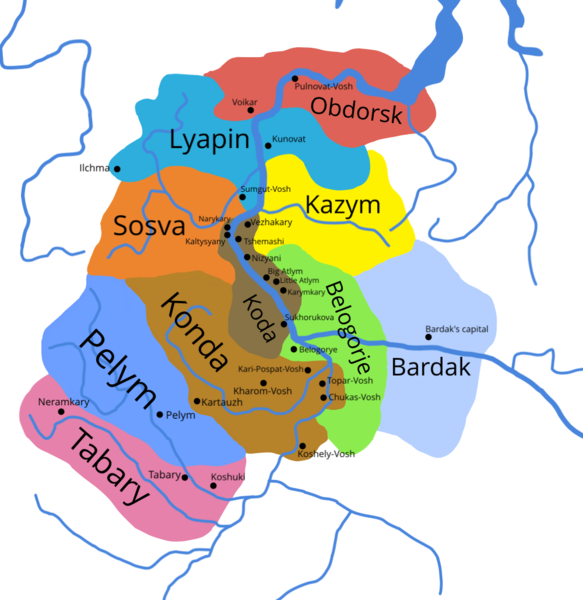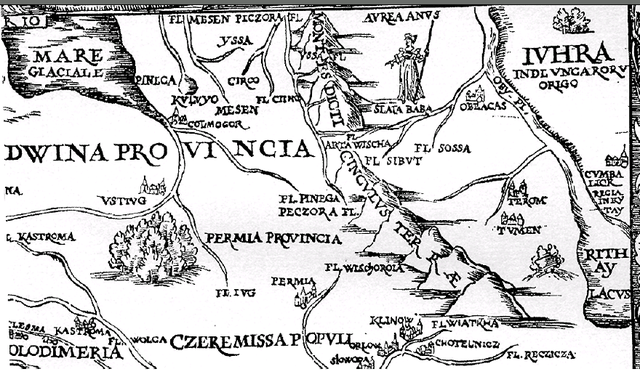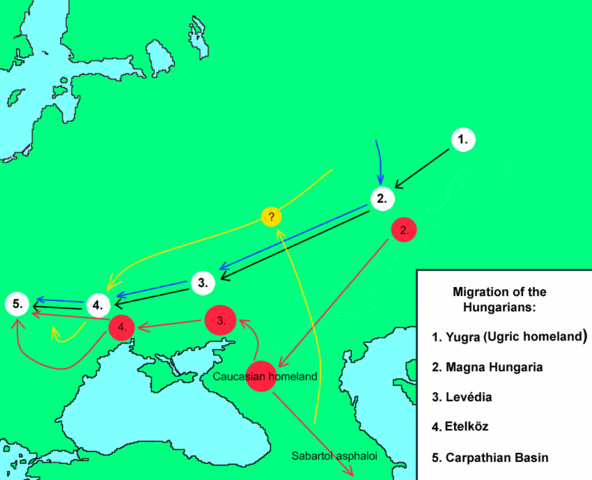
| YUGRA
Yugran principalities in the 15th century Yugra or Iuhra (Old Russian Jugra; Byzantine Greek Ouggroi; Latin: Ongariae) was a collective name for lands and peoples between the Pechora River and Urals (modern north-west Russia), in the Russian annals of the 12th–17th centuries. During this period the region was inhabited by the Khanty (a.k.a. Ostyaks; Hanty) and Mansi (Vogul; Maansi) peoples. Yugra was also the source for the name of the Ugric language family (including both the Khanty and Mansi languages, as well as Hungarian).
The modern Khanty-Mansi Autonomous Okrug is also sometimes known as Yugra, and Yugra is a part of its official Russian name.
History :
This section does not cite any sources.
Yugra (Iuhra), "the place of origin of Hungarians" (inde ungaroru origo) on Sigismund von Herberstein's 1549 map of Moscovia. Herberstein placed the label Iuhra east of the Ob River, while a statue of Aurea anus (Latin: "Golden Old Woman"), a.k.a. Slata baba ("Golden Idol") can be seen west of the Ob.
The 12th century missionary and traveller Abu Hamid al-Gharnati gives one of the earliest accounts of the region, which he calls Yura in Arabic :
But beyond Wisu by the Sea of Darkness there lies a land known by the name of Yura. In summers the days are very long there, so that the Sun does not set for forty days, as the merchants say; but in winters the nights are equally long. The merchants report that Darkness is not far (from them), and that the people of Yura go there and enter it with torches, and find a huge tree there which is like a big village. But on top of the tree there sits a large creature, they say it is a bird. And they bring merchandise along, and each merchant sets down his goods apart from those of the others; and he makes a mark on them and leaves, but when he comes back, he finds commodities there, necessary for his own country ... (Al Garnati:32)
The Golden Lady of the Obians was apparently an idol of the Yugrans. The first reports of the Golden Lady are found in the 14th-century Novgorod Chronicles, with reference to Saint Stephan of Perm. Next, the golden idol is mentioned in the 16th century by the subjects of the Grand Duke of Moscow, commissioned to describe the trade and military routes of the expanding Russia. The first non-Russian known to have examined the Golden Lady is Maciej Miechowita, a professor at Cracow University. The golden idol appeared on Sigismund von Herberstein's map of Moscovia published in 1549, and on a number of later maps, e.g. Gerhard Mercator's "Map of the Arctic (1595)", where it is labeled Zolotaia Baba (from Russian "Golden Lady" or "Golden Idol").
In connection with Yermak's campaign, the Siberian Chronicle also mentions the golden woman: a hetman of Yermak's, by the name of Ivan Bryazga, invaded the Belogorye region in 1582 and fought the Ob-Ugrians there, who were defending their holiest object – the golden woman. (See Karjalainen 1918:243–245, Shestalov 1987:347.) And Grigori Novitski's statement that in earlier days there used to be in one shrine in Belogorye together with the copper goose "the greatest real idol", and that the superstitious people "preserved that idol and took it to Konda now that idol-worshipping is being rooted up", has also been regarded as relating to the golden woman (Novitski: 61).
Of the "Copper Goose" Novitski wrote the following :
The goose idol very much worshipped by them is cast of copper in the shape of a goose, its atrocious abode is in the Belogorye village on the great river of Ob. According to their superstition they worship the god of waterfowls – swans, geese and other birds swimming on water ... His throne in the temple is made of different kinds of broadcloth, canvas and hide, built like a nest; in it sits the monster who is always highly revered, most of all at the times of catching waterfowls in nests ... This idol is so notorious that people come from distant villages to perform atrocious sacrifice to it – offering cattle, mainly horses; and they are certain that it (the idol) is the bearer of many goods, mainly ensuring the richness of waterfowls ...
Comparisons of different Yugran traditions indicate that the goose was one of the shapes or appearances of the most popular god of the "World Surveyor Man", and that Belogorye is still sometimes referred to as his home. Novitsky also describes a site for worshipping this "World Surveyor" or "Ob Master" :
The home of the Ob Master was presumably near the stronghold Samarovo in the mouth of the river Irtysh. According to their heathen belief he was the god of the fish, depicted in a most impudent manner: a board of wood, nose like a tin tube, eyes of glass, little horns on top of the head, covered with rags, attired in a (gilt breasted) purple robe. Arms – bows, arrows, spears, armour, etc – were laid beside him. According to their heathen belief they say about the collected arms that he often has to fight in the water and conquer other vassals. The frenzy ones thought that the atrocious monster is especially horrifying in the darkness and in the large waters, that he comes through all the depths where he watches over all fish and aquatic animals and gives everyone as much as he pleases.
—
Novitsky: 59.
We all know why you have come here – you want to pervert us from our ancient beliefs with your smooth-tongued flattery and damage and destroy our revered helper, but it is all in vain for you may take our heads but this we will not let you do.
—
Novitsky: 92–93
The idol was carved of wood, attired in green clothes, the evil looking face was covered with white iron, a black fox skin was placed on its head; the whole sanctuary, especially his site which was higher than anywhere else, was decorated with purple broadcloth. Other smaller idols nearby which were placed lower were called the servants of the real idol. I think there were many other things in front of him – caftans, squirrel skins, etc.
—
Novitsky: 93
We will now obey the ruler's regulations and ukase. So we will not discard your teaching, we only beg you not to reject the idol so revered by our fathers and grandfathers, and if you wish to christen us, honour also our idol, christen it in a more honourable manner – with a golden cross. Then we will decorate and build a church with all the icons ourselves, as a custom goes, and we will place ours also among these.
—
Novitsky: 94–95
Yugrian Principalities and relations with the Tatars and Russians :
This section does not cite any sources.
The coat of arms of Kondia There are three or four known proto-states of the Yugran inhabitants, both Khanty and Mansi. The Principality of Pelym was located in the basin of the Konda river and stretched from the mouth of the Sosva River near Tavda up to Tabory. The stronghold of the Pelym princes was also a significant religious centre; a sacred Siberian larch grew in its surroundings and even in the 18th century people used to hang the skins of sacrificed horses on its branches. Near the sacred tree was a worship storehouse with five idols of human figure, and smaller storehouses with high pillars and human-faced peaks around it for storing sacrificial instruments. The bones of sacrificial animals were stored in a separate building (Novitski: 81).
The Principality of Konda (mainly Mansi) formed a large semi autonomous part of the Pelym principality, according to the tax registers from 1628/29 it was inhabited by 257 tax-paying Mansi. The treasures of Prince Agai of Konda who was imprisoned by the Russians in 1594 gives us a good picture of the wealth of the Yugran nobles of this period. Namely, the Russians confiscated two silver crowns, a silver spoon, a silver beaker, a silver spiral bracelet, "precious drapery" and numerous pelts and precious furs (Bahrushin 1955,2:146). The third part of the Pelym principality was the region of Tabary, in which inhabited 102 adults in 1628/29. Preceding the coming of the Russians the Mansi of this region were farmers and according to the tradition Yermak collected tribute in the form of grain (Bahrushin 1955, 2:147).
It is believed the Yugran people or Ob-Ugrians had made trade with many countries far and wide since the earliest times. This trade was described in journals attributed to Abu Hamid al-Gharnati the Arab traveller during the 12th century :
And from Bolghar merchants travel to the land of heathens, called Wisu; marvellous beaver skins come from there, and they take there wedge-shaped unpolished swords made in Azerbaijan in their turn… But the inhabitants of Visu take these swords to the land that lies near the Darkness [Yugra] by the Black Sea [now known as the White Sea], and they trade the swords for sable skins. And these people take the swords and cast them into the Black Sea; but Allah the Almighty sends them a fish which size is like a mountain [a whale]; and they sail out to the fish in their ships and carve its flesh for months on end.
—
Bahrushin 1955,2: 58–59[verification needed]
From the 13th to 15th centuries, Yugra was supposed to pay tribute to Novgorod. But taxes could be collected only by means of armed forces. The chronicles describe several campaigns, mentioning the strong resistance of Yugran princes who took shelter in their strongholds. After the annexation of Ustyug by Moscow in the 14th century, Muscovite campaigns began instead of the Novgorodan ones.
In the 15th century, the most important Russian stronghold in Permland and the starting point for all expeditions going to the East was the diocese established on the Vym River by Stephan of Perm. In 1455,the Mansi of Pelym launched a campaign under the command of Prince Asyka. Moscow reciprocated by forming an alliance with Prince Vasily of Great Perm who together with the warriors of Vym who took part in the 1465 expedition to Yugra (Bahrushin 1955,1:76). It is recorded in the Russian Chronicles that, in 1465, as a result of this raid, two minor "Yugrian" princes (Kalpik and Chepik) were compelled to submit to the Russians and pay tribute. They were soon deposed. In 1467, during a second campaign, Prince Asyka himself was captured and brought to Vyatka (Bahrushin 1955,2:113). In 1483, Moscow sent forth another expedition against the princes of Yugra and Konda where the "grand duke" Moldan was captured (Bahrushin 1955,2:113).[verification needed]
In 1499, Moscow dispatched a great force against "Yugra" (Pelym; led by Prince Semyon Kurbski), Konda or Koda (led by Prince Pyotr Ushatyi), and the "Gogulichi", the free Voguls or Mansi). The 4000 strong army, using dog and reindeer teams, reached the Lyapin stronghold of the Khanty, located on the river of the same name (Bahrushin 1955,1:76–77). In the source it is told that 40 strongholds were taken and 58 Khanty and Mansi princes captured in the expedition. At the end of the 15th century the Grand Duke of Moscow assumed the honorary title of Prince of Yugra. By the 16th century, several Yugran princes were paying tribute to the Siberia Khanate and participated in their military ventures against Russian settlers protected by Cossacks and Komi auxiliaries who were chasing the Yugran natives from their homes.
In response the Khanty and Mansi of Pelym continually sent forth counter-campaigns to the lands of Great Perm. Thus, the year 1581 went into history as the year of the raiding of Kaigorod and Cherdyn. According to Russian estimates, the army of the Mansi and their allies, the Tartars, stood 700 strong (Bahrushin 1955,1:99; 2:144). Continuing resistance to border conflagration led to the launching of a campaign in 1582–84 arranged and financed by the Stroganovs and led by the Cossack leader Yermak Timofeyevich, which began with the destruction of a Mansi war band that had invaded the Russian settlers territory and ended as a punitive expedition against the Pelym Mansi and their ally the Siberian Khan. In some sources, Alach, Prince of Koda figures as an important ally of the Siberian Khan Kuchum Khan and is said to have been awarded one of the Yermak mail-coats taken from the enemy (Bahrushin 1955, 1:114).
In 1592, another Russian campaign against the Mansi of Pelym was launched. It ended in 1593 when the stronghold of Prince Ablegirim of Pelym was taken, the prince and his family captured and a Russian fortress erected in the heart of the stronghold. Although in the following year the Pelym principality suffered the loss of its lands lying on the Konda River, the Mansi did not give up resistance. In 1599, they once again brought "war, theft and treachery" to the banks of the Chusovaya River and Kurya River and plundered the Russian settlements there (Bahrushin,2:143–144).
The close connections between the Yugrans and the Turkic Tartars are also demonstrated by the fact that even in the 1660s, the idea of restoring the Kuchum Khanate was still popular with the Khanty of Beryozovo (Bahrushin,2:143–144). [verification needed] It was only in the middle of the 17th century that Moscow succeeded in subduing Yugra.
In
the 18th century, the successors of the Principality of Pelym and
Principality of Konda – princes Vassili and Fyodor –
lived in Pelym. They became Russianized and performed various duties
for the Tsarist government. The Mansi, however, considered them
still as their rulers. The fact that the ancient family of princes
ruled on in Konda is also proved by a tsar letter from 1624 :
Prince Kyntsha of Konda received a deed of gift from the Tsar in 1680 which confirmed his noble position. Even in the 18th century the Konda princes were known for their relative independence. It is assumed that, as late as 1715, Prince Satyga of Konda and his 600 armed men made an attempt to impede the Christianisation of the Konda Mansi (Novitski: 98). From 1732–47, Konda was ruled by Satyga's son Prince Osip Grigoryev, followed by his own son Prince Vlas Ossipov. According to recent research by Aado Lintrop, one of the great-grandchildren of Satyga, the teacher of the Turinsky community school, Aleksander Satygin claimed the title "Prince of Konda" as late as 1842.
Hungarian Urheimat :
Yugra and its vicinity to the south are considered to be the place of origin of the Hungarians (in Hungarian magyar oshaza). One hypothesis says that the name Hungary is a variety of the name Yugra (the Hungarians also were known in several languages under the name of Ugri, and are still known under this name in Ukrainian).
The Hungarian language is also the closest linguistic relative of Khanty and Mansi. It is believed that Hungarians moved West from Yugra, first settling on the western side of the Urals, in the region known as Magna Hungaria (Great Yugria). Then they moved to the region of Levédia (present-day east Ukraine), then to the region of Etelköz (present-day west Ukraine), finally reaching the Carpathian Basin in the 9th century.[citation needed]
Source :
https://en.wikipedia.org/ |



